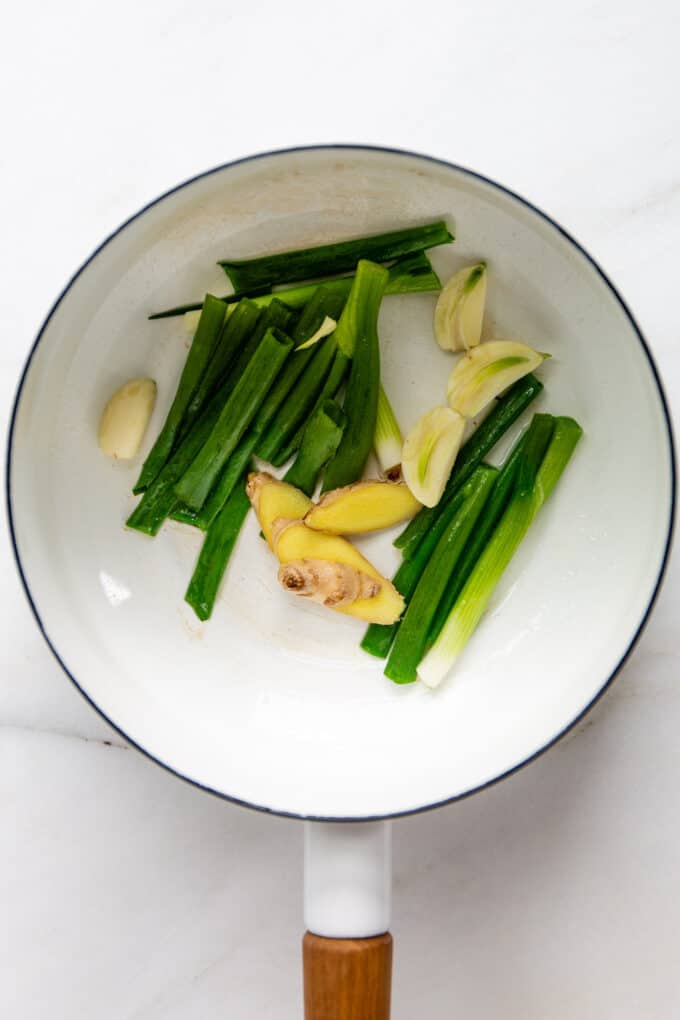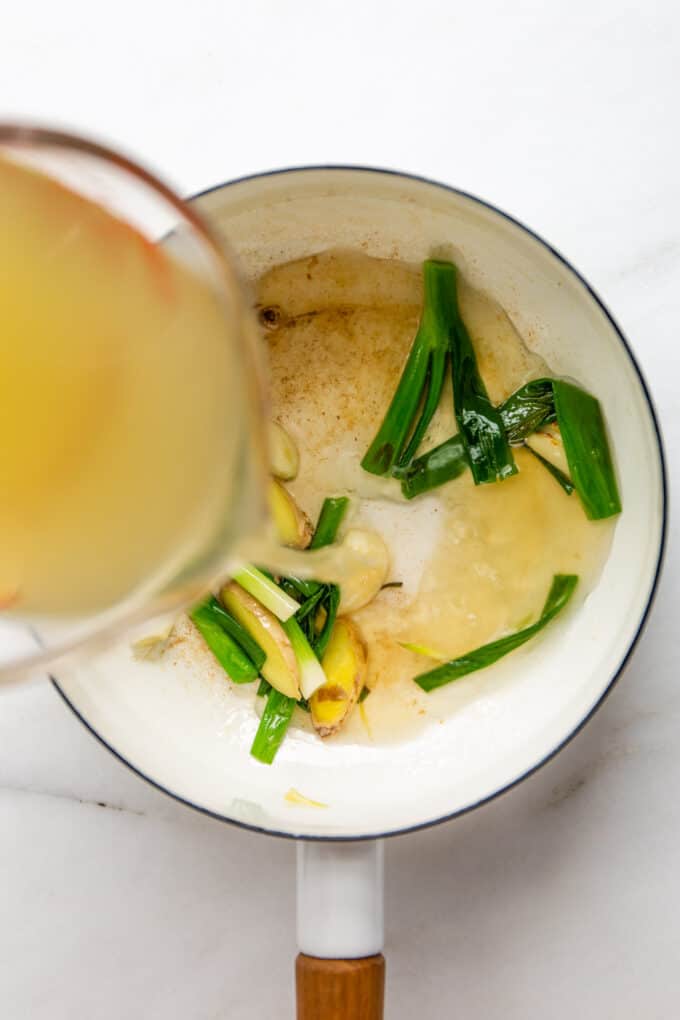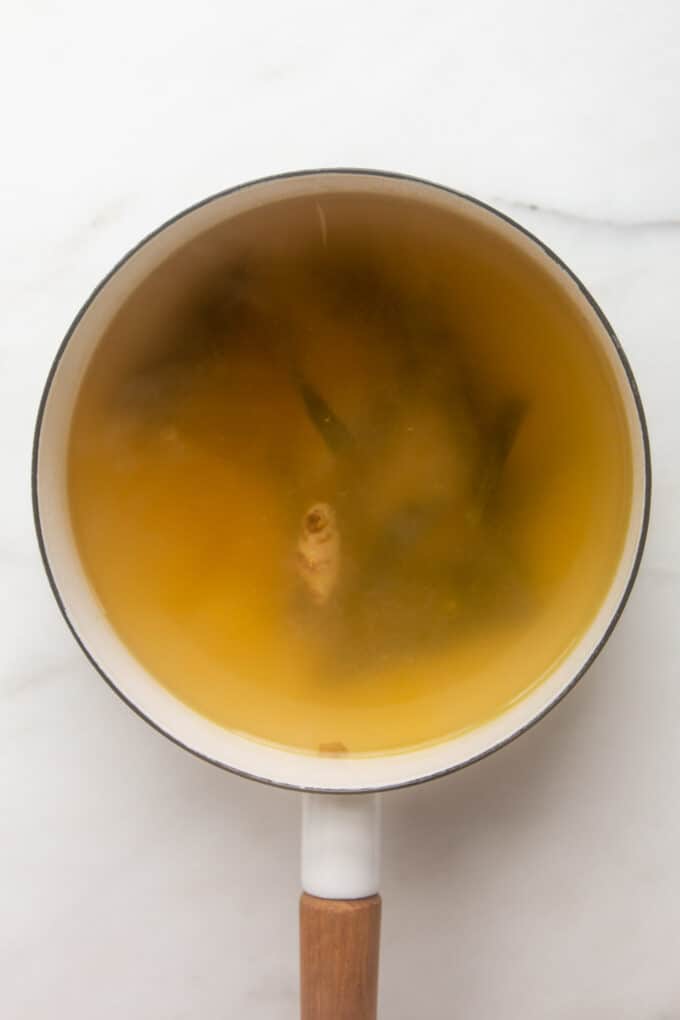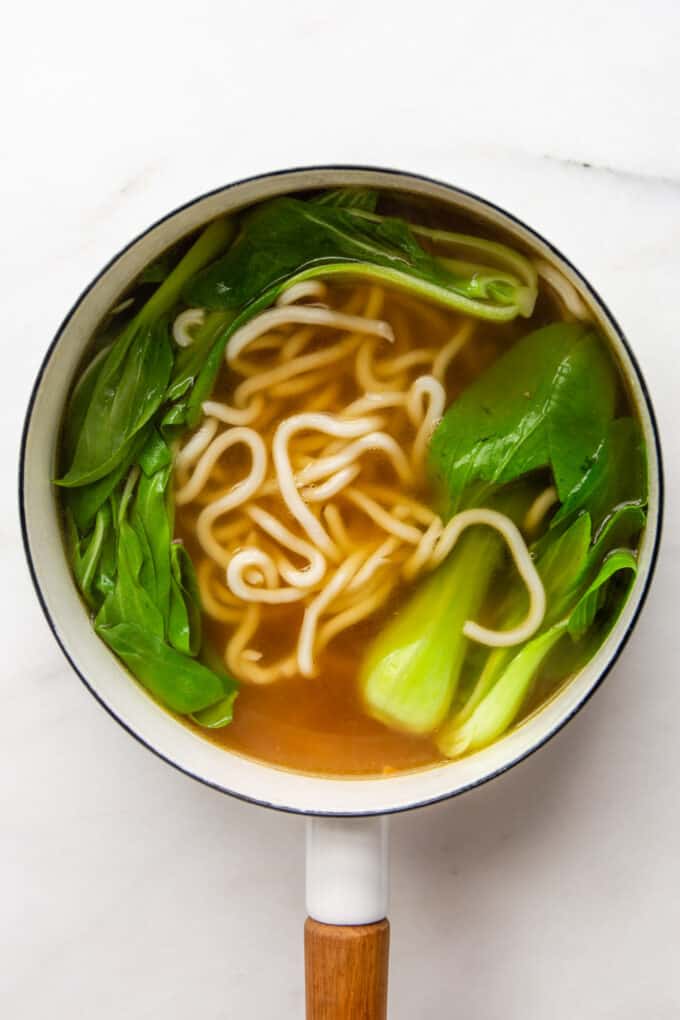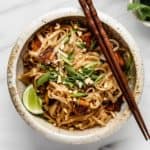Udon Noodle Soup
This simple vegetarian Udon Noodle Soup is made with a light clear vegetable stock, udon noodles and some boy choy for a simple, light and cozy vegetarian and vegan soup.
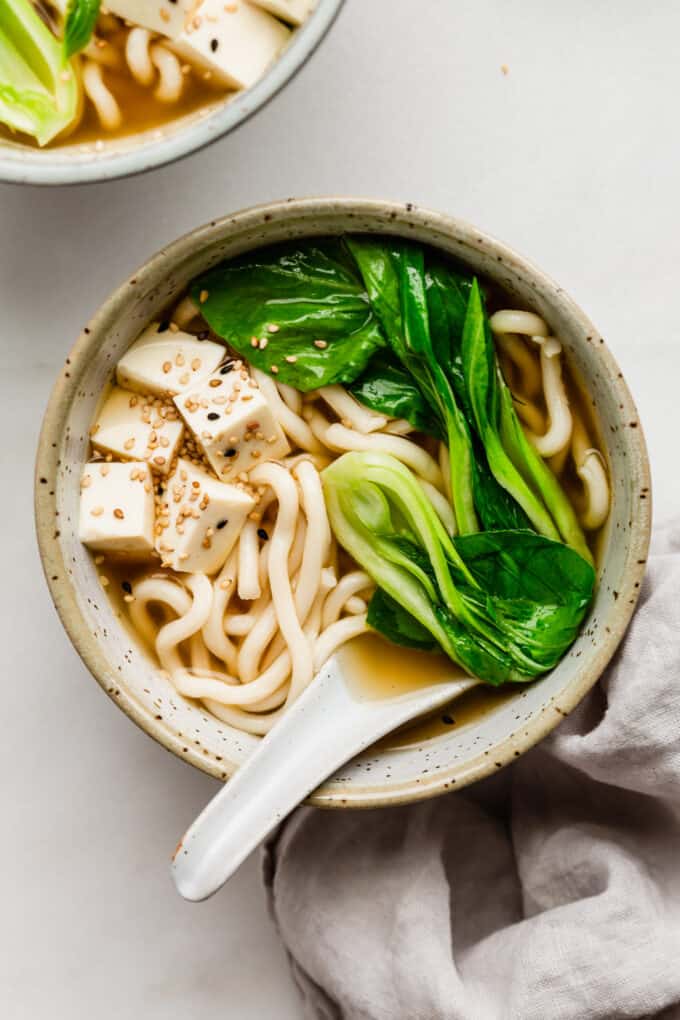
What is the difference between udon soup and ramen?
While both of these soups come from Japanese culture, there are many differences between udon soup and ramen.
- Different types of noodles: Ramen of course uses ramen noodles, while Udon soup uses udon noodles. Udon noodles are much thicker and wider than ramen noodles.
- Broth/Dashi: these two types of soup usually have a different styles of broth. Ramen is often seen with creamy broths or spicy broths, while udon soup (also sometimes called Kake Udon) is made with a simple clear both.
- Egg: Ramen often features an egg added to the soup, while udon soup doesn’t.
Why you’ll love this udon soup
- Ready in 30 minutes. This is a quick and easy udon soup that is ready from start to finish in just 30 minutes when you want a cozy meal ready quickly.
- Vegetarian and vegan. This recipe is perfect for a vegetarian and vegan-friendly meal. Just make sure to check that your udon noodles are vegan. (generally, they are.)
- Customizable. You can add whatever seasoning, spices, vegetables or protein you love to this soup recipe. It’s easy to customize however you like.
Udon noodle soup ingredients

- Udon noodles: for this recipe, I use vacuum-sealed cooked udon noodles which can be found at most supermarkets.
- Vegetable broth: use a good quality vegetable broth or stock for this recipe for best results.
- Ginger: fresh ginger is a key ingredient that will infuse the vegetable broth with flavour.
- Garlic: this is another key ingredient used to help flavour the vegetable broth.
- Scallions: these are also added to the vegetable broth for flavour. It’s important to use scallions (also called green onions) and not regular onion.
- Tamari: you can substitute this with soy sauce if needed.
- Sesame oil: a little goes a long way. This adds some depth and earthiness to the broth.
- Mirin: this is a type of rice wine used in Japanese cooking that is similar to sake, but with a lower alcohol content.
- Bok choy: I use baby bok choy in this recipe. Any type of bok choy will work.
The best type of udon noodles to use
There are several different types of udon noodles you can buy from your local grocery store or Asian supermarket. All three of these types are perfect to use in this soup!
- Fresh udon: you’ll find these at most Asian markets. They are sold in the refrigerated section in a package. They are delicious if you can get your hands on them and they can be added directly to the soup and boiled for 2-3 minutes to cook.
- Packaged udon: these udon noodles can be found at most grocery stores and are usually pre-cooked and vacuum sealed. They can be added directly to the soup and need just a minute or two to cook for the noodles to separate.
- Frozen udon: these tend to be fresh udon noodles that have been placed in the freezer to preserve them. They’ll need to be defrosted before using them so you can separate the noodles.
How to make udon noodle soup
step 1
Heat the avocado oil in a large pot on medium heat then add the scallions, garlic and ginger and saute for 2 minutes. Then add the vegetable broth and bring to a light boil, then cover and let simmer on low heat for 20 minutes.
Tip: if you have more time, you can let the soup simmer for 60 minutes. This will infuse the broth with even more flavour.
Step 2
Once the broth has finished simmering, use a strainer and remove the aromatics from the broth. Then bring the broth to a light boil and add the tamari, sesame oil and Mirin. Add the udon noodles and bok choy and stir together until the udon noodles are soft. Serve right away.
How to store and reheat leftovers
When storing udon noodle soup it’s important to store the noodles separately from the broth. If the noodles are left in the broth they will become soggy.
To store remove the noodles and bok choy from the broth and place them in a container. Place the broth in a separate container and store it in the fridge for up to 3 days.
Reheat in a pot on the stove or in the microwave.
Udon soup variations
Add protein: try adding some soft tofu or for non-vegetarians some chicken, shrimp or prawns. (I like to add soft tofu and it can be added directly at the end of the bowl of soup.)
Add toppings: cilantro, sesame seeds, sriracha, wakame (seaweed), green onions and bean sprouts would all make delicious toppings to this udon soup!
Add more veggies: add in whatever vegetables you love like snow peas, mushrooms, Chinese broccoli, cauliflower or spouts.
Tips for making this recipe perfectly
- Start with a good broth. Since this recipe is made with store-bought vegetable broth or stock, it’s important to choose a brand that you know is flavourful and tastes great. Since the broth in this recipe is very simple, having a good broth to start with is important.
- Let the stock cook for longer if you have time. While the recipe is great when the broth cooks for 20 minutes, it’s even better if you can cook it for an hour! This will infuse the broth with even more flavour.
- Adjust seasoning to taste. Depending on the brand of broth you use, you may find that you need more or less seasoning in the soup. If this is the case adjust as needed. You can always add more tamari or Mirin!
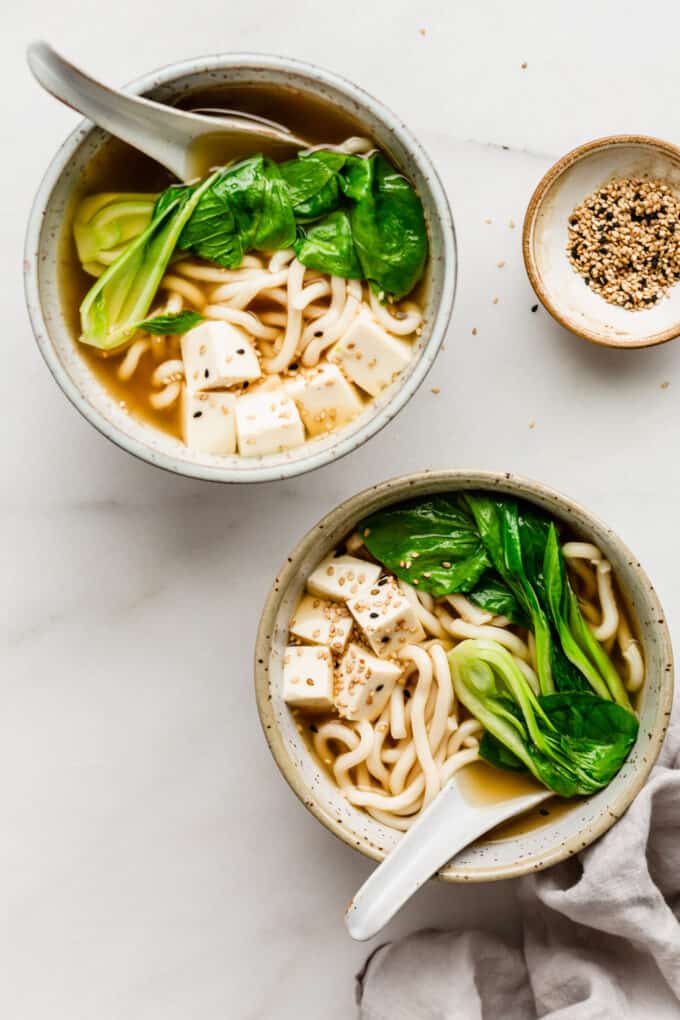
Udon soup FAQ
You can freeze the broth, but not with the udon noodles and vegetables. The noodles and vegetables will become soggy when frozen.
Yes! Udon soup is made with a simple broth, udon noodles and bok choy for a healthy meal. Each serving of udon soup has 383 calories, 2 grams of fibre and 15 grams of protein
If you don’t have mirin you can add 1 tbsp rice wine vinegar, sherry or sake. If you don’t have any of these you can also add 1/2 tbsp of honey or agave for some sweetness.
More soup recipes to try
If you tried this Udon Noodle Soup or any other recipe on the blog let me know how you liked it by leaving a comment/rating below! Be sure to follow along on Pinterest, Instagram and Facebook for even more deliciousness!

Udon Noodle Soup
- Prep Time: 5 minutes
- Cook Time: 25 minutes
- Total Time: 30 minutes
- Yield: 2 servings 1x
- Category: Main
- Method: Boil
- Cuisine: Japanese
- Diet: Vegetarian
Description
A simple and delicious udon noodle soup ready in 30 minutes.
Ingredients
- 1 tbsp avocado oil
- 2 scallions, cut in half
- 3 garlic cloves
- 3 slices of ginger (slice about 2cm thick pieces)
- 1 lire vegetable broth
- 1–2 tbsp tamari
- 1/2 tsp sesame oil
- 1 tbsp mirin (can sub sake, rice wine vinegar or sherry)
- 500 grams of udon noodles
- 2 cups baby bok choy
- 1 pack of soft tofu (optional)
Instructions
- Heat the avocado oil in a large pot on medium heat, then add the scallions, garlic and ginger and saute for 2 minutes.
- Add the vegetable broth and bring to a light boil, then cover and let simmer for 20 minutes. This will infuse the soup with flavour.
- Remove the lid from the soup and bring it back up to a light boil. Add the tamari, mirin, sesame oil udon noodles and bok choy and cook for 3-4 minutes or until the noodles are tender.
- Taste and adjust seasoning if needed and serve.
- If adding soft tofu, add the tofu directly to your bowl.
Notes
Use a good quality vegetable broth for this recipe.
If you have time, let the broth simmer for 60 minutes to infuse it with even more flavour!
Nutrition
- Serving Size: 1/2 of the recipe
- Calories: 383
- Sugar: 3g
- Fat: 7g
- Carbohydrates: 59g
- Fiber: 2g
- Protein: 13g

